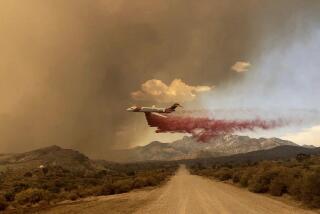How an important Central Coast vineyard fought off the Alamo fire
Two of the current wildfire season’s biggest blazes, the Alamo and Whittier fires, have ravaged tens of thousands of acres in California’s Central Coast region, in San Luis Obispo and Santa Barbara Counties, respectively. And the Alamo fire, after a day burning out of control, turned abruptly south toward the Santa Maria Valley, threatening one of the oldest and most venerated vineyards in the state, Bien Nacido Vineyard, as well as its famous tenants, Au Bon Climat and Qupé wineries. Both were spared, but a vineyard adjacent to them, North Canyon, wasn’t as lucky.
Bien Nacido’s benches and hillsides are planted with more than 800 acres of vine grapes and contain orchards, pastureland and a number of outbuildings as well. Since 1989, it’s also been the home to a sprawling corrugated winery facility housing Qupé and Au Bon Climat, on the north end of the property.
Qupé’s Bob Lindquist heard about the fire on Thursday, soon after it was reported near Twitchell Reservoir. He was away from the winery and called Chris Hammell, who heads up all of Bien Nacido’s ranch operations. They discussed the threat and got in touch with the Miller family — Stephen, and his two sons, Marshall and Nicholas. The family has owned this ranch since 1969, and it has had grapevines in the ground since 1973.
On Friday afternoon, the fire line descended into a steep canyon loaded with fresh fuel and erupted: A huge plume of gray-white smoke shot high into the sky, visible for miles. The fire ballooned in size and intensity, until it was no longer predictable or containable. That’s when Lindquist said he had to evacuate.
Just to the north of Bien Nacido lay North Canyon Vineyard, a 900-acre site owned by Treasury Wine Estates and home to prized pinot noir fruit. Cal Fire evacuated the northern valleys of Santa Maria and set about fighting the fire in the steep canyons east of the vineyards.
After 24 hours they’d slowed the progress of the flames. Then, on Saturday afternoon, the Whittier fire erupted near Lake Cachuma, about 40 miles south and east of the Alamo fire. With lives and residences under threat, the decision was made to divert most of the Alamo fire resources to the Whittier fire.
Within hours, Bien Nacido had lost its defenders. That’s when Hammell enlisted all available staff — including Michael Brughelli, the vineyard’s sales manager, who had experience as a volunteer firefighter — to protect the property. They rounded up the cattle and other animals and transported them to safety. (The county fair, scheduled to start later this weekend, opened its gates early to accommodate evacuated animals.)
At his disposal Hammell had water trucks, a bulldozer, hoses and pipes. The team began to widen the roads on the perimeter of the vineyard to create a corridor that they hoped the fire line wouldn’t be able to cross, then doused those corridors with water.
Two days later, on a tour of the vineyard’s perimeter, the line of demarcation between blackened hills and green vine rows was thickly outlined by these barrier roadways. “Without Chris doing that work I have no doubt the fire would have made it to the vineyard,” Nicholas Miller said. Lindquist agreed. “I wasn’t sure we’d have a vineyard to come back to on Monday,” he said, “but everything’s still in one piece.”
Almost in one piece, the Ranch lost more than 1,000 acres of pastureland to the blaze.
North Canyon wasn’t as fortunate. Standing in Bien Nacido’s Z-Block, home to prized Syrah, and looking over Powerline Canyon to North Canyon is a study in two basic shades: the green of the vine rows and the gray, char and ash of burned vegetation. The fire consumed every inch of the slopes that overlook the vines, and tendrils of fire spilled into corridors.
According to Rachel Ashley, Treasury’s vice president of vineyard production, the vineyard lost 10% of its vines to the fire, or up to 90 acres. There were no injuries and no damage to structures. Most of the vines, as hardy as the oaks that line the hills, are defiantly green amongst the char.
It remains to be seen whether the smell of smoke will in any way linger on the surface of the fruit, a phenomenon known as smoke taint. If it does, the entire crop, and the wine made from it, runs the risk of bearing an unpleasant, disruptive impression of smoke that obtrudes on more delicate aromas and flavors.
For the most part, however, the smoke of the fire traveled north and east, away from the vineyards. And at this stage in the season the fruit is still quite hard, waxy and impenetrable. “The fire moved through the canyon quickly,” says Rachel Ashley, “and we’re at an early stage of the grape-growing season where the risk of smoke taint is lower.”
ALSO:
Culinary SOS: Brown Sugar Kitchen’s waffle recipe
The Taste food event returns to Paramount Studios Labor Day weekend
Four new brewery tasting rooms to visit in Los Angeles and Orange County this summer
More to Read
Eat your way across L.A.
Get our weekly Tasting Notes newsletter for reviews, news and more.
You may occasionally receive promotional content from the Los Angeles Times.





